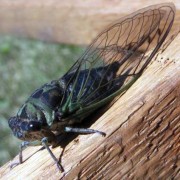Springtime for Chicharra and Chiquirín
Lovesick cicadas electrify the air with an amorous din as they hurdle from puberty to old age
“In the spring,” wrote Tennyson in his poem Locksley Hall, “a young man’s fancy lightly turns to thoughts of love.” The same could be said of old cicadas in Central America.
Every spring, millions of them emerge from the ground to molt, unfurl their new wings, mate—and sing. The ensuing swarm can be a pelting, deafening tempest of bugs so intense that wedding planners try to schedule around them. Most cicadas are otherwise not considered pests, although too many larvae in an orchard may kill a few trees, from whose roots they suck sap.The last five or so weeks of a cicada’s life packs in adolescence, adulthood and old age, following a larval “childhood” of one or several years, although no species among dozens of Central American genera can match the longevity of the notorious “17-year locusts” in the United States.
In Guatemala, the term for cicadas is chicharra, a word of K’ekchi origin used as far away as Nicaragua and often bastardized into cigarra. That may sound like something to smoke, but there are no records that cicadas are ever smoked like tobacco. They are, however, roasted and eaten; for guerillas in all three of Central America’s recent civil wars, they were practically a seasonal fruit. Cicadas are somewhat richer in protein than fruit, however, and the females are preferred because they are meatier than their mates.
The reason for this is that much of the female’s abdomen is an ovary that produces up to 600 eggs, which she deposits into slits that she chisels into tree roots. The male’s abdomen, contrarily, has a large, empty “echo” chamber that amplifies his singing organs. For guerillas, then, the females were the “deep-dish” variety and the males the “extra-crispy.” Both have a crunch.
Unlike crickets or locusts, male cicadas sing by pulsating membranes called timbals, rather than by violin-like rubbing. And although the females are mute, they are not deaf; in fact, the whole musical hub-bub is the male’s way of setting the mood. The female recognizes the call of her species with “ears” called tympana. In larger species, like Proarna championi, which can approach 4 cm in length and rival a hummingbird for impact, the mating song can, at close range, approach 120 decibels.
The song of one common species is onomatopoeically called chiquirín, because its series of sharp chirps climax in a sonorous, motor-like hum. Cheek-cheek-cheek-cheek-cheek-cheek-areeeeeeeeeennn. Many people find this tune to be soothing, and moviemakers record it and other cicada music to enhance their sets with creepiness and other ambiences.
Over a century ago, while British entomologist W.L. Distant began cataloging Central American cicadas, he noticed that some cicadas have a repertoire of three or even four songs. Aside from the deafening mating call, there is a softer “honeymoon croon” that a male serenades his mate with after she accepts his advances; the pair separates after an hour (more or less) of coitus. Males also emit a distress screech when snagged by predators, and some species have a “fight song” that tells other males to back off.
Though cicadas are associated with rural areas, where they are prized by collecting children, they do well in any urban locale with enough of the right kind of trees. The verdant quarter of San Salvador, which includes the National Zoo and the presidential compound, is abuzz with love-struck cicadas in April and May.
Because they are wont to sing loudly and endlessly, their nickname, chicharra, is often applied to human chatterboxes. That cicadas are so honored is probably of little importance to them, as they hum away in eternal their cacophony with delightful abandon.
In larger cicada species, which can approach 4 cm in length, the mating song can, at close range, approach 120 decibels.

THANK YOU!!! 🙂 Cicada…. im from Guatemala and I never knew how to explain the bugs to myAmerican friends. I love chicharras!
Can you tell us more about this? I’d care to find out more details.